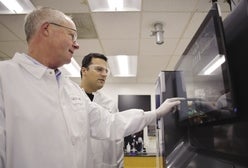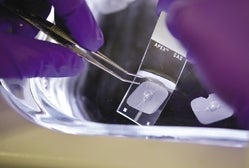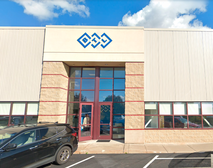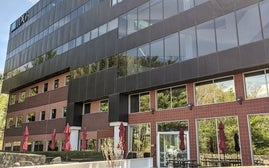Manufacturers find international success
For years, Michael Schmidt ran VenMill Industries, a manufacturer of disk repair machines for video stores and libraries where 30 percent of business was conducted abroad. As the disk repair business started to dwindle away, the team decided to change course, knowing exporting would be an integral part of whatever they did next.Their next business, SoClean, is an Oxford manufacturer making the world's first automated cleaning system for sleep apnea-aiding CPAP equipment. Business has more than doubled since 2011 and will triple again this year.
Because SoClean makes such a niche product, the company is working to get it on the market wherever it's needed. That means international markets, which currently bring in about 13 percent of business annually, will continue to be a big focus going forward, Schmidt said.
“Sometimes people don't grow anymore in the U.S., and then they think about international. That is a mistake,” Schmidt said. “You have to think global from very beginning.”
Whether they're introducing a new product, supplying parts to foreign companies or expanding their own facilities, Central Massachusetts manufacturers see exporting as a way to take their business to the next level.
SoClean currently sells to Europe, Australia, Hong Kong, Singapore and Thailand and is working on expanding to Russia, China and Japan. Because they're a new player on the market selling a targeted product, they're in the honeymoon phase of consistent and growing business at home and abroad.
“We're enjoying the growth of introducing a totally new product to market,” Schmidt said.
In total, Massachusetts brought in about $25.2 billion in export revenue in 2015, according to the Foreign Trade Division of the U.S. Census Bureau, ranking the commonwealth 18th in the nation for export revenue.
Revenue significance
Manufacturers of all shapes and sizes rely heavily on exporting.
Larger companies, like Marlborough's Boston Scientific, reported international net sales accounted for about 43 percent of net sales in 2015. North Chicago, Ill.-based AbbVie, with a research center in Worcester, reported 41 percent of net revenues came from abroad last year.
On the smaller side, Worcester-based Kinefac Corp, a metal former and processor, has been an exporter since the late 1960s. The company has machines in 25 countries on all seven continents, including Antarctica.
“It started with the sale of a single machine to Europe, and once you have a machine on the ground, other people hear about it,” Owner and Director Leslie Greis said. “It can grow organically.”
International business grew when U.S. customers started bringing their operations abroad, and when Kinefac itself started to seek out partnerships with foreign companies.
The company mainly exports metal forming machines, metal coiling machines and centrifugal cleaners, Greis said.
International complications
Central Massachusetts is an exporter of mostly industrial products, said Julia Dvorko, Central Massachusetts regional director for the Massachusetts Export Center, which works mostly with manufacturers.
A lot of the parts the region exports are highly specialized, so even as economic conditions abroad change, exporting from the region remains relatively steady, Dvorko said.
That said, the increasing value of the dollar has made U.S. products more expensive abroad, but it hasn't been disruptive recently, she said.
“There are occasional slowdowns, but I don't know that this economic cycle there has been a slowdown,” she said.
Micron Products, a sensor maker in Fitchburg, mostly exports silver plated sensors that can be used in electrodes for EKG tests. About 40 percent of its revenue comes from exports, but the return on investment can sometimes take awhile, said Chief Financial Officer Derek Welch.
It takes three to six weeks to manufacture certain products and get them shipment-ready. Then, the products actually have to get there, which can oftentimes take 45-90 days. Because of this, the company does its best to set reasonable payment timelines for its customers, but the cash conversion cycle -- from purchase of raw materials to payment -- can take many months.
Further complicating matters is the fact that the company can't continue to borrow on accounts receivable that come in later than a bank's predetermined parameters, no matter what the payment terms between Micron and its customer are.
To deal with the long cash conversion cycle, Micron has been working with MassDevelopment's Working Capital Guarantee Program, which bridges the gap between companies and banks to extend borrowing times by lending money, freeing up capital as a result.
The fluctuating price of silver is another challenge. Sensors are sold based on the price of silver as of shipping time, so that can be either good or bad for the company depending on the market's direction.
Finding local partnerships
Manufacturers who want to export come to the Export Center with all levels of experience and questions, Dvorko said. If a company has never exported before, they'll be taken through the whole process, from which markets make the most sense to finding the right overseas partners.
One of the keys to establishing a market presence – and having staying power – is creating partnerships with agents and distributors in foreign markets.
SoClean, for example. has technicians on the ground in every country it serves to fix any bugs.
Eventually, a customer can graduate to expanding itself abroad in robust markets, Dvorko said.
While some manufacturers have found success using the Internet to contact customers directly, having a partner on the ground is still very much the norm, Dvorko said. Customers in some countries, like Japan, can be hard to reach without a local partner, she said.















0 Comments